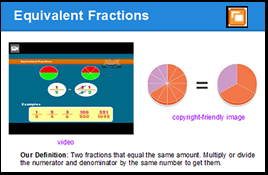 There is a wealth of research to suggest that vocabulary knowledge is the single best predictor of student academic achievement across all curriculum areas. Experts agree that vocabulary development is an attainable goal. If given the opportunity to receive effective vocabulary instruction, most students can acquire vocabulary at rates that will improve their comprehension and also their chances for success in school. Technology is an effective and engaging tool that can be used to improe vocabulary acquisition for all learners and engage them in the learning process. Google Presentation offers some features that make it an attractive tool for a lesson in which students work collaboratively to construct knowledge about vocabulary by creating vocabulary cards.
There is a wealth of research to suggest that vocabulary knowledge is the single best predictor of student academic achievement across all curriculum areas. Experts agree that vocabulary development is an attainable goal. If given the opportunity to receive effective vocabulary instruction, most students can acquire vocabulary at rates that will improve their comprehension and also their chances for success in school. Technology is an effective and engaging tool that can be used to improe vocabulary acquisition for all learners and engage them in the learning process. Google Presentation offers some features that make it an attractive tool for a lesson in which students work collaboratively to construct knowledge about vocabulary by creating vocabulary cards.Pages
▼
December 3, 2011
Build Vocabulary Cards with Google Presentation
 There is a wealth of research to suggest that vocabulary knowledge is the single best predictor of student academic achievement across all curriculum areas. Experts agree that vocabulary development is an attainable goal. If given the opportunity to receive effective vocabulary instruction, most students can acquire vocabulary at rates that will improve their comprehension and also their chances for success in school. Technology is an effective and engaging tool that can be used to improe vocabulary acquisition for all learners and engage them in the learning process. Google Presentation offers some features that make it an attractive tool for a lesson in which students work collaboratively to construct knowledge about vocabulary by creating vocabulary cards.
There is a wealth of research to suggest that vocabulary knowledge is the single best predictor of student academic achievement across all curriculum areas. Experts agree that vocabulary development is an attainable goal. If given the opportunity to receive effective vocabulary instruction, most students can acquire vocabulary at rates that will improve their comprehension and also their chances for success in school. Technology is an effective and engaging tool that can be used to improe vocabulary acquisition for all learners and engage them in the learning process. Google Presentation offers some features that make it an attractive tool for a lesson in which students work collaboratively to construct knowledge about vocabulary by creating vocabulary cards.November 6, 2011
Improve Search Skills - A Google a Day
|
Searching for information is a process that involves critical thinking. A Google a Day is a trivia game that provides students and grownups with a playful way to improve search skills. Every day Google posts a question that is complex enough that a regular Google search won't yield the solution. Players have to put on their thinking caps to find the answers. Here are some things you should know about a Google a day: |
October 29, 2011
GoogleDocs for Learning on Scoop.It
 |
| View Google Docs for Learning on Scoop.It |
If you have ideas to share, please take a minute to complete my Google form and share.
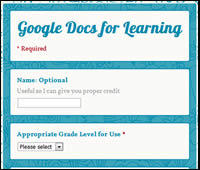
October 27, 2011
Zoom.It: Publish Zoomable Images
Zoom.It is a free and user-friendly Cool Tool for embedding, viewing and sharing images. Just copy an image link into the box on the website and in return receive a link or embed code to your zoomable image. Click on the tools at the bottom of this awesome poster, published by The Partnership for 21st Century Skills, to experience Zoom.It as you think about the 4 C's.
October 25, 2011
GoogleDocs Presentation: New Look and Features
Recently Google released a new version of its online presentation software and with it comes some additional features that have been available in traditional presentation software programs like PowerPoint and Keynote. Here are some of the highlights:
October 23, 2011
The Flipped Classroom Infographic
Check out this infographic about The Flipped Classroom created by Jeremy F. Stayer of Ohio State University.
October 18, 2011
Learn About Culture Through Images
Culture is a very popular topic of study in our 6th grade curriculum. Larry Ferlazzo has identified some great photo resources for Learning About Different Cultures on his blog, Larry Ferlazzo's Websites of the Day...for Teaching ELL, ESL, & EFL. I decided to combine Larry's resources with ThingLink, to create a visual launcher to help students expand their visual and cultural literacy skills in the 24/7 classroom.
October 10, 2011
3 Interactive Math Tools to Engage Students
The flexibility of virtual manipulatives and interactive math tutorials can provide opportunities for all students to master math.. Here are 3 interactive sites that work well with students working on their own computers, projected in front of the class, or on an interactive board.
October 9, 2011
GoogleDocs Templates: A Virtual Copy Machine
If you're looking for an easy and efficient way to provide students with a starting point for a digital project, Google Docs Templates can help. You can save time and guide the learning by providing students with a consistent page format by using and creating your own templates. A Google Docs template is like a virtual copy machine. There are plenty of user-submitted templates already created and available for public use and there is even a category for Students and Teachers. Here are some tips and tricks to get you started.
October 5, 2011
Manage Google Docs with an Assignment Tracker
One of the challenges of rolling out Google Docs for all students at our school is in managing all those docs students are turning in. Teachers are experiencing the frustration of cluttered In Boxes taken over by individual messages from students sharing their assignments. Fortunately, I have found an awesome idea from John Miller @162 that utilizes a Google Form as an Assignment Tracker. The idea is innovative, efficient and simple. Here's how John's invention works:
October 2, 2011
Collaborative Brainstorming with Google Docs Drawing Tools
September 25, 2011
YouTube for Teachers
As educators, most of us recognize the benefits of using video for learning and we also realize that exposing students to the wide array of content available on YouTube can be dangerous. Finally, it's here... The YouTube.edu site!
10 Minute Tech Tools
I've put together a new collection of user-friendly tech tools for busy teachers on ScoopIt. Unlike my other collections, the criteria for this list is not based on a common theme, instead these tools are included because they will take 10 minutes or less for you to start using and they are versitile enough to be used to enhance teaching across the curriculum. No login or account setup is required.
September 24, 2011
Use Google Docs to Facilitate a Digital Writer's Workshop
August 22, 2011
August 19, 2011
CoolTools for Multimedia Projects on Scoop.It
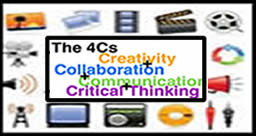 Multimedia projects provide students with opportunities to acquire 21st century skills by requiring them to gather, integrate and synthesize information as they collaborate and communicate within a digital environment. Effective multimedia projects require students to construct knowledge and use higher-level thinking skills to remix and present content.
Multimedia projects provide students with opportunities to acquire 21st century skills by requiring them to gather, integrate and synthesize information as they collaborate and communicate within a digital environment. Effective multimedia projects require students to construct knowledge and use higher-level thinking skills to remix and present content.
August 18, 2011
Comics in the Classroom
Comics are a powerful teaching tools that provide educators with engaging visual content to support all learners. Not only are the appealing and kid-friendly, they provide an opportunity for reluctant readers to visualize as they read, as well as providing a means for reluctant writers to communicate a story with a beginning, middle, and end. There has been a lot of attention focusing on the benefits of using comics in the classroom. Here are some resources for getting started:
August 17, 2011
Spell with Me: A Tool for Flickr
Spell with Me is a quick and easy tool that translates letters in words into Flickr images. Type in any word and this tool will generate one image for each letter and then provide you with the embed code to include the image on your blog
or website. Use this tool to create eye-catching graphics for your digital resources or let students use it to reinforce spelling or vocabulary practice, but be careful not to overuse it, a little goes a long way.
August 16, 2011
YouTube Tools: Maximize Instruction and Tame Videos
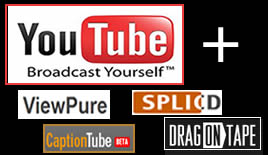 Video in the classroom is a dynamic resource for supporting the curriculum and engaging students. A wide range of video with educational value is available on YouTube, but sometimes those videos need to be tweeked to maximize instruction. Want to eliminate the extras, share only a snippet of a video, or string several videos clips together? Here
are some free and user friendly tools to help educators make the most of
YouTube videos in the classroom.
Video in the classroom is a dynamic resource for supporting the curriculum and engaging students. A wide range of video with educational value is available on YouTube, but sometimes those videos need to be tweeked to maximize instruction. Want to eliminate the extras, share only a snippet of a video, or string several videos clips together? Here
are some free and user friendly tools to help educators make the most of
YouTube videos in the classroom. July 29, 2011
ThingLink: Make Images Interactive
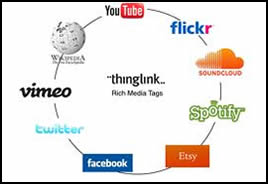 Thinglink is an interactive image tool that provides users with the ability to turn any image into a multimedia launcher. Users can create multiple "hot spots" on specific parts of an image and turn the image into a multimedia launcher. Embed video, record audio with the click of a button and a free SoundCloud account, or link to any website. Compatible with any blog or website that has a widget to support javascript, this is a great tool for those of us who use Blogger, Wikispaces or WordPress.
Thinglink is an interactive image tool that provides users with the ability to turn any image into a multimedia launcher. Users can create multiple "hot spots" on specific parts of an image and turn the image into a multimedia launcher. Embed video, record audio with the click of a button and a free SoundCloud account, or link to any website. Compatible with any blog or website that has a widget to support javascript, this is a great tool for those of us who use Blogger, Wikispaces or WordPress. July 28, 2011
Bloom's Taxonomy Presented Visually
 | ||||||
July 25, 2011
Scoop.it - Collect and Share Information Visually
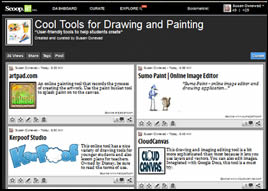 Scoop.it is a curation service that
allows users to collect information about a topic of interest and
display it all on one attractive visual page. The tool integrates
instantly with Twitter and Facebook, allowing you to share
with the click of a button, and a newly added feature allows users to
embed a preview of your Scoop.it page into any blog, wiki or website. See the Cool Tools for Drawing sample I created below..
Scoop.it is a curation service that
allows users to collect information about a topic of interest and
display it all on one attractive visual page. The tool integrates
instantly with Twitter and Facebook, allowing you to share
with the click of a button, and a newly added feature allows users to
embed a preview of your Scoop.it page into any blog, wiki or website. See the Cool Tools for Drawing sample I created below..July 21, 2011
Tag Galaxy
Tag Galaxy is a Cool Tool to visually explore word relationships. Just type in a term and watch a 3D orbiting galaxy of words and their associations evolve Click on any word to move it to the center of the galaxy, then click on it again and watch the globe populate with tagged images from Flickr.
July 19, 2011
The Blooming Orange
I've always been interested in new ways to view and think about Bloom's Taxonomy and the folks at Learning Today
have created a poster worth sharing. To help teachers get thinking
about ways to apply Bloom's higher-order thinking skills in the
classroom, they've put a spin on the traditional hierarchy and limited
the number of verbs in each section to create The Blooming Orange.
They've popped Bloom's verbage into the segments of an orange and intentionally depicted it as a circle to illustrate the fact that often these skills do not occur in isolation, they often occur simultaneously. This Blooming Orange presents itself as a teacher-friendly tool for planning and possibly an easier way for everyone to think about Bloom's. Be sure to click on the link below to visit the Learning Today blog and print a copy of this poster to hang in your classroom.
They've popped Bloom's verbage into the segments of an orange and intentionally depicted it as a circle to illustrate the fact that often these skills do not occur in isolation, they often occur simultaneously. This Blooming Orange presents itself as a teacher-friendly tool for planning and possibly an easier way for everyone to think about Bloom's. Be sure to click on the link below to visit the Learning Today blog and print a copy of this poster to hang in your classroom.
July 15, 2011
Present.Me
July 13, 2011
Simplify and Summarize Digital Text
July 10, 2011
Cool Tools for Teaching Vocabulary
I spent the first part of my summer working with teachers to help them learn to use technology as a tool for differentiating reading instruction to help all learners succeed. During that time we experimented with many different tools for teaching vocabulary. Here is a glance at the list of tools the course participants found to be user-friendly and useful for students and teachers.
WordStash: Build Vocabulary Cards
WordStash is a dictionary based website for helping students learn vocabulary
and more. Teachers can sign up for a free account to create and store word lists
to support written text. With the click of a button, users can access
definitions, example sentences from context and pictures to support the
word. Once created, teachers will have a set of digital flash cards to
use to help students practice the words and concepts through a couple of no-nonsense games and
quizzes. Students can access the vocabulary activities through a link, without logging in.
At first glance, this seems like a handy tool for reviewing vocabulary, but after experimenting with the tool myself, I realized that the tool can also be used to help students build their own knowledge about vocabulary terms and concepts, which makes it a much more appealing tool.
At it's most basic level, users can create a word card in a few quick and simple steps.
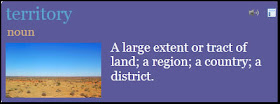
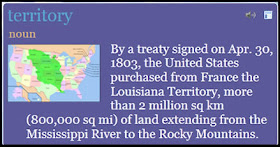
Sign up for a free teacher account and try WordStash for yourself.
At first glance, this seems like a handy tool for reviewing vocabulary, but after experimenting with the tool myself, I realized that the tool can also be used to help students build their own knowledge about vocabulary terms and concepts, which makes it a much more appealing tool.
At it's most basic level, users can create a word card in a few quick and simple steps.
- Add term
- Choose the appropriate part of speech from a list.
- Click on the appropriate definition to add it to the card.
- Add an image from the Flicker or Wikipedia database.

- Add term
- Choose from a list to determine the part of speech
- Read the given definitions, then search for an article on the Internet that uses the word in context. Word stash has a button to find context clues, but I found it easier to do my own search.
- From the context, develop your own definition of the word. Type that definition on the word card..
- Add a more accurate image from the database by typing in a more manually adjusting the search term. In this case, the term "territory" yielded a generic image, but type in "Louisiana Purchase" did the trick.

Sign up for a free teacher account and try WordStash for yourself.
June 29, 2011
Lingro - Turn digital text into a clickable dictionary
Lingro is an amazing online tool that turns any website or digital text file into an interactive dictionary where users can click on a word to view it's definition and hear it's pronunciation. Support by 12 languages, Lingro is also a very useful tool for translating text.
Lingro is easy to use. Just copy and paste any web address into Lingro's web browser and click on a word, or use the file viewer to upload a document and translate it in the same way. One of the most impressive features of Lingro is that it stores and remembers all the words you click on and allows you to easily create and store words lists. Then, with the click of a button, Lingro turns your word lists into an online flash card game.
This tool does not require a login to use the most basic features so it can be a handy tool for students without an email address, but teachers should create a free account to take advantage of additional features, such as storage, history and word lists.
.Try Lingro for yourself
Lingro is easy to use. Just copy and paste any web address into Lingro's web browser and click on a word, or use the file viewer to upload a document and translate it in the same way. One of the most impressive features of Lingro is that it stores and remembers all the words you click on and allows you to easily create and store words lists. Then, with the click of a button, Lingro turns your word lists into an online flash card game.
This tool does not require a login to use the most basic features so it can be a handy tool for students without an email address, but teachers should create a free account to take advantage of additional features, such as storage, history and word lists.
.Try Lingro for yourself
June 24, 2011
Pulse for iPad: A Gorgeous News Feed Reader
Pulse is an iPad app that collects multiple sources of your favorite news feeds and displays them in a convenient and attractive way to create a highly enjoyable reading experience.
News sources you select are arranged as a stream. Just drag the screen vertically to scan all your sources, then drag it horizontally to view particular articles within each source. Tap the screen to read an article in text view or view it as a full webpage. Pulse will even collect and display your Twitter stream. Sharing is as easy as a couple of taps.
To get a glimpse of what Pulse can do, please watch the video below and try Pulse for yourself, available from the iTunes store.
To get a glimpse of what Pulse can do, please watch the video below and try Pulse for yourself, available from the iTunes store.
June 21, 2011
VocabGrabber: Generate Vocabulary Lists from Digital Text
 |
VocabGrabber is a Cool Tool that makes it easy to generate vocabulary lists from digital text. Just copy and paste text into a box and watch the tool generate a word cloud in which the most frequently used words appear larger in size. Those words are sorted into categories so users can extract specific content-related words from the cloud, or generate a general vocabulary list. Clicking on a word displays a definition, examples from context and a visual word map generated through the company's Visual Thesaurus Tool.
Be sure to use the handy toolbar add-on for maximum efficiency when you try VocabGrabber for yourself.
Be sure to use the handy toolbar add-on for maximum efficiency when you try VocabGrabber for yourself.
June 16, 2011
Twurdy: Search by Appropriate Readibility Levels
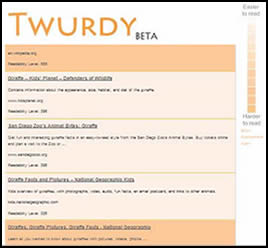
Twurdy is a Google powered search tool that displays results at appropriate readability levels. Just enter a search term to get color-coded results which determine how easy the page will be to understand. This is certainly a useful tool to help all learners succeed and also a good tool to add to any teacher's toolkit of resources.
If you think the name of this search engine will be difficult to remember, perhaps knowing that it was derived from a play on words, "Too Wordy?", will help you remember it.
Try Twurdy
June 5, 2011
Online Bulletin Board of EdTech Blogs
As a tech facilitator much of my success can be attributed to what I learn through the contacts I've made via my Personal Learning Network. Summer is a great time for educators to begin to build a personal learning network and so I've decided to simultaneously introduce a new tool for collaboration and try an experiment to demonstrate the power of a PLN.
If you have received a personal invitation to view this blog through Twitter, that means your blog has been published on the online bulletin board of Good EdTech Blogs I created using a user-friendly post-it note tool called Lino It. I am asking you to give the tool a try and add your favorite edtech blog to the bulletin board, then send a Tweet to the author with an invitation to contribute and continue the process. If successful, I think this bulletin board will grow rapidly and demonstrate the power of a PLN in addition to creating a great list of resources for those who are just starting to build a PLN. If you just happen to be reading this blog, please join us. You can post your own edtech blog, or your favorite, then do spread the word.
About the tool:
Lino It is a tool for creating a bulletin board of online sticky notes and a good tool for teachers to try this summer for collaborating with team members as you reflect and think about ideas for the upcoming school year. Working on a project? Collecting resources for a unit of study? Why not start with this simple and easy-to-use bulletin board. You can set up an account for free and share your bulletin board with a target group or make it public and share it with the world.
View or contribute to the EdTech Blogs Resources Board:
http://bit.ly/lts4rj
Try Lino It for yourself:
http://linoit.com
Stay tuned to this blog this summer as I continue to focus on ways to help educators develop a personal learning network.
If you have received a personal invitation to view this blog through Twitter, that means your blog has been published on the online bulletin board of Good EdTech Blogs I created using a user-friendly post-it note tool called Lino It. I am asking you to give the tool a try and add your favorite edtech blog to the bulletin board, then send a Tweet to the author with an invitation to contribute and continue the process. If successful, I think this bulletin board will grow rapidly and demonstrate the power of a PLN in addition to creating a great list of resources for those who are just starting to build a PLN. If you just happen to be reading this blog, please join us. You can post your own edtech blog, or your favorite, then do spread the word.
About the tool:
Lino It is a tool for creating a bulletin board of online sticky notes and a good tool for teachers to try this summer for collaborating with team members as you reflect and think about ideas for the upcoming school year. Working on a project? Collecting resources for a unit of study? Why not start with this simple and easy-to-use bulletin board. You can set up an account for free and share your bulletin board with a target group or make it public and share it with the world.
View or contribute to the EdTech Blogs Resources Board:
http://bit.ly/lts4rj
Try Lino It for yourself:
http://linoit.com
Stay tuned to this blog this summer as I continue to focus on ways to help educators develop a personal learning network.
May 28, 2011
Google Art Project: Explore World Museums
As the end of the year approaches, teachers are often looking for engaging activities to keep their energetic students on task. Perhaps you might want to consider taking your students on a virtual field trip to explore art museums from around the world.
Google Art Project is an interactive website that uses the same street view technology you've probably seen in Google Maps to allows visitors to virtually explore museums and view hundreds of pieces of art. Even better, visitors can view them at incredible zoom levels to get even closer than you could if you were actually standing in front of the original painting. Visitors can even create and share their own collection of masterpieces.
May 20, 2011
The Flipped Classroom
As an instructional tech facilitator my goal is to help teachers progress through the stages of technology adoption to get to the point at which they are using technology as a tool for learning, rather than using it as an add on to supplement traditional learning activities. To do that successfully, teachers must adjust their roles, moving from traditional teacher to learning coach or facilitator. Jonathan Bergmann and Aaron Sams are a couple of innovative teachers who have developed an approach to teaching and learning known as The Flipped Classroom, which certainly supports the idea of teachers as learning coaches.
May 18, 2011
Edublogs Free Tools Challenge
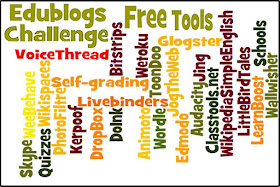 The Free Tools Challenge is a great online professional development opportunity for busy teachers provided by Edublogs. Designed to help participants learn to use free Web 2.0 tools, this 30 day challenge encourages us all to try one new tool each week through challenge activities created by by guest bloggers. I got the opportunity to be a guest blogger for the challenge and the activitiy I created, Free Tools Challenge #25: Using Jog the Web in the 24/7 Classroom, was published earlier this week.
The Free Tools Challenge is a great online professional development opportunity for busy teachers provided by Edublogs. Designed to help participants learn to use free Web 2.0 tools, this 30 day challenge encourages us all to try one new tool each week through challenge activities created by by guest bloggers. I got the opportunity to be a guest blogger for the challenge and the activitiy I created, Free Tools Challenge #25: Using Jog the Web in the 24/7 Classroom, was published earlier this week.May 14, 2011
Text Compactor: Simplify and Summarize Text
Text Compactor is a free online tool for summarizing and simplifying text. It is extremely user-friendly and requires no login so it's a perfect tool for students to add to their own toolkits of resources.
Just copy and paste some digital text into the box, use the slider to determine the percentage of text you want to end up with, and view the simplified text.
Use it as a tool to help struggling readers of all ages. Try it at textcompactor.com.
May 10, 2011
JogTheWeb for Guided Student Learning
One of the best ways to use JogTheWeb is as a tool to create flexible, guided activities to help all students learn. It's easy to design a Jog for success if you set a goal of providing students with multiple ways to access and acquire information. Design your lessons to include video, text written at a variety of reading levels, simulations and interactive websites then see if it makes a difference in the success of all students. Take a look at a very simple Jog I created, Let's Explore the Nervous System, to view multiple ways to present information to students.
May 3, 2011
Tweet Topic Explorer
If you appreciate a good word cloud you might be eager to learn about a tool that creates a word cluster out of the information people post on Twitter, commonly referred to as tweets.
This word cluster identifies the most frequently used words tweeted and also groups them to show relationships. Although the sample of my tweets below is only an image, you go to the actual website then click on any word to highlight it in the tweets.
This word cluster identifies the most frequently used words tweeted and also groups them to show relationships. Although the sample of my tweets below is only an image, you go to the actual website then click on any word to highlight it in the tweets.
May 2, 2011
Photosynth - Capture the World in 3D
Photosynth is a cool tool for capturing and viewing the world in 3D. This tool takes a series of photos and weaves them together to create a virtual tour. You and your students can explore the many photosynths already created simply by visiting the website, or create your own by signing up for an account.
Please enjoy this photosynth of the Chicago Skyline.
Try it for yourself at phyosynth.net
April 29, 2011
10 Minutes of Tech for Busy Teachers
I used JogTheWeb to create a mixed-bag of quick tech tools for teachers to explore in ten minutes or less. All of the tools in this jog are extremely user-friendly, free and require no login. The tools are simple and versatile enough to assist in the teaching of just about any content to students of all ages. Ten minutes is all it will take to check out one of these tools and add it to your tech toolkit of resources.
10 Minutes of Tech for Busy Teachers
10 Minutes of Tech for Busy Teachers
April 28, 2011
Jog The Web
Jog The Web is a cool tool that allows users to assemble tidy packages of web content. For teachers it can be a tool for providing students with easy access to guided learning.
The websites within a Jog are live and can be explored right within the page frame, which solves problems related to students getting lost within multiple windows. Even better, Jog authors can annotate pages within the Jog and also create original pages with unique content.
This appears to be a very promising tool for education because it's user-friendly, engaging and interactive.
View Sample: A Jog for teachers, featuring several Web 2.0 tools
Using Glogster to Construct Knowledge
The websites within a Jog are live and can be explored right within the page frame, which solves problems related to students getting lost within multiple windows. Even better, Jog authors can annotate pages within the Jog and also create original pages with unique content.
This appears to be a very promising tool for education because it's user-friendly, engaging and interactive.
View Sample: A Jog for teachers, featuring several Web 2.0 tools
Using Glogster to Construct Knowledge
April 2, 2011
Why Glog?
March 31, 2011
Blogger: More Ways to Share
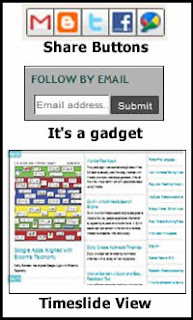
newer options that make sharing your blog easier.
- Share Buttons:
You can add share buttons to the bottom of your posts so visitors can quickly share your post on one of their favorite social media sites, like Twitter or Facebook. This is a handy feature, but unfortunately the buttons are small and appear in gray scale. Maybe blogger will work on this. In the meantime, add these buttons by going to Design, then click on the Edit link in the Blog Posts box. Try the buttons for yourself at the bottom of this post.
- Follow by Email:
This is a new gadget that allows visitors to quickly enter an email address into a box in the sidebar to receive automatic blog updates by email. When you add this gadget Blogger will walk you through the steps to get you up and running. See sample in the sidebar
- View Options:
Everyone has a preferred method of viewing, and while I'm going to stick with the traditional web log format, it's nice to know your visitors can choose to view your blog in a variety of ways. To do this, simply add a backslash followed by the word view to your blog address. Modifying the address will take you to a new page with a variety of viewing options. As far as alternate views go, I am fond of the timeslide view. Here is an example:
My blog address: http://d97cooltools.blogspot.com
Alternate viewing options: http://d97cooltools.blogspot.com/view/timeslide
Look in the upper right-hand corner of the new screen to switch views.
March 30, 2011
Google Apps Aligned with Bloom's Taxonomy
Kathy Schrock, has aligned Google Apps with Bloom's Taxonomy. Please visit her site to access the amazing interactive map she has assembled, then submit a quick form to add your ideas and justifications for why you might have students use these tools in the respective cognitive areas in which they appear. Thanks Kathy!
Go to Kathy Schrock's Bloom's Revised Taxonomy page:
 | |||||||
| View live version, courtesy of Kathy Schrock http://school.discoveryeducation.com/schrockguide |
March 27, 2011
Wordle Flashback
Two years ago I was excited enough about Web 2.0 tools to actually start this blog. I started with Wordle, a simple word cloud generator. After all this time, I must admit I am still passionate about using Wordle. I find myself using it regularly in my teaching, even though several new word tag generators have evolved, including Taxedo, Tag Cloud, and the ever-popular WordPress rotating tag cloud.
Still, I love Wordle for it's simplicity. Just go to the Wordle website, type some text into a box, click a button and your text becomes a Word Cloud. Anyone can do it, but the real trick is in how it's used. After all, words that appear more frequently within the text appear larger in size within the word cloud.
Here are my top 3 favorite ways to use Wordle:
Still, I love Wordle for it's simplicity. Just go to the Wordle website, type some text into a box, click a button and your text becomes a Word Cloud. Anyone can do it, but the real trick is in how it's used. After all, words that appear more frequently within the text appear larger in size within the word cloud.
Here are my top 3 favorite ways to use Wordle:
- Copy and paste the text from a few good articles about a specific topic into Wordle to get the main ideas and vocabulary. Use it as a starting point for a lesson to help students construct knowledge.
- Copy and paste student generated text into Wordle for self-analysis of writing. Words and phrases that are overused will jump out.
- Wordle a current event topic, then use it to generate a classroom discussion.
 |
| This Blog, Wordled |
March 20, 2011
Qwiki - A Multi-Media Search Engine
Qwiki is a multi-media search engine designed to improve the way people experience information by appealing to users on a human level. A Qwiki search delivers content in the form of a narrated, interactive slideshow that tells a story. Although it's relatively new, there are millions of topics available for searching now.































